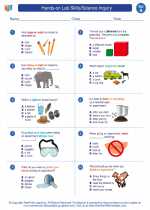Hands-on Lab Skills/Science Inquiry -> behavioral adaptations
Behavioral Adaptations
Behavioral adaptations are the actions, reactions, or habits of an organism that help it survive in its environment. These adaptations can be learned or instinctual and are developed over time through the process of natural selection. Here are some key points to understand about behavioral adaptations:
- Types of Behavioral Adaptations: Behavioral adaptations can include things like migration, hibernation, social behavior, and communication. These behaviors help organisms find food, avoid predators, reproduce, and thrive in their specific habitats.
- Examples of Behavioral Adaptations: Some examples of behavioral adaptations include birds migrating to warmer climates during the winter, bears hibernating to conserve energy during the cold months, and bees communicating the location of nectar sources to other members of their colony through dances.
- Development of Behavioral Adaptations: Behavioral adaptations can be developed through a combination of genetic inheritance and learning from experience. For example, some animals are born with instincts that help them find food or build shelters, while others learn through observing and imitating the behavior of older members of their species.
- Importance of Behavioral Adaptations: Behavioral adaptations are essential for the survival and reproductive success of organisms. They allow animals to cope with changes in their environment and increase their chances of finding food, avoiding danger, and finding mates.
Study Guide for Behavioral Adaptations
Here are some key concepts to study when learning about behavioral adaptations:
- Identify and describe different types of behavioral adaptations.
- Explain how specific behavioral adaptations help organisms survive in their environments.
- Provide examples of behavioral adaptations in various animal species.
- Discuss the role of natural selection in the development of behavioral adaptations.
Understanding behavioral adaptations is crucial for comprehending how organisms interact with their environments and how they have evolved to overcome challenges. It also provides insights into the diversity of behaviors found in the animal kingdom.
[Behavioral Adaptations] Related Worksheets and Study Guides:
.◂Science Worksheets and Study Guides First Grade. Hands-on Lab Skills/Science Inquiry
Study Guide Hands-on Lab Skills/Science Inquiry
Hands-on Lab Skills/Science Inquiry  Worksheet/Answer key
Worksheet/Answer key Hands-on Lab Skills/Science Inquiry
Hands-on Lab Skills/Science Inquiry  Worksheet/Answer key
Worksheet/Answer key Hands-on Lab Skills/Science Inquiry
Hands-on Lab Skills/Science Inquiry  Worksheet/Answer key
Worksheet/Answer key Hands-on Lab Skills/Science Inquiry
Hands-on Lab Skills/Science Inquiry  Vocabulary/Answer key
Vocabulary/Answer key Hands-on Lab Skills/Science Inquiry
Hands-on Lab Skills/Science Inquiry  Vocabulary/Answer key
Vocabulary/Answer key Hands-on Lab Skills/Science Inquiry
Hands-on Lab Skills/Science Inquiry 

 Worksheet/Answer key
Worksheet/Answer key
 Worksheet/Answer key
Worksheet/Answer key
 Worksheet/Answer key
Worksheet/Answer key
 Vocabulary/Answer key
Vocabulary/Answer key
 Vocabulary/Answer key
Vocabulary/Answer key

The resources above cover the following skills:
EARTH AND SPACE SCIENCE
Earth’s Place in the Universe
Observe seasonal patterns of sunrise and sunset to describe the relationship between the number of hours of daylight and the time of year (e.g., more hours of daylight during summer as compared to winter).